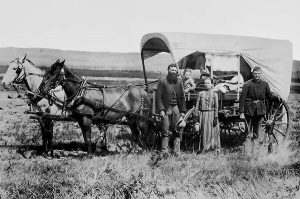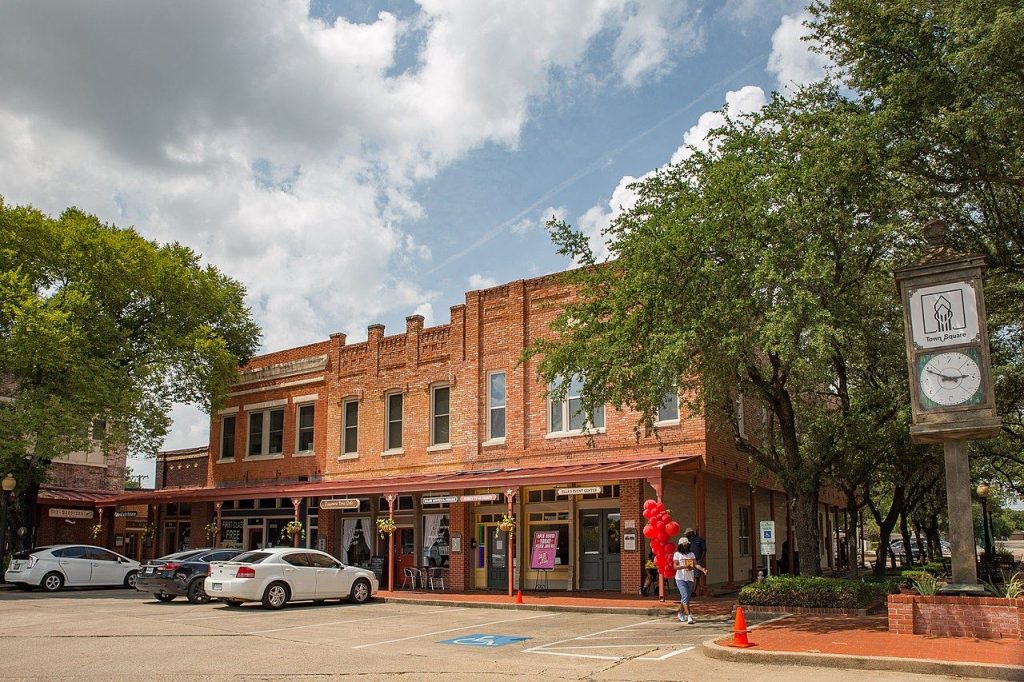Before the courthouse square: Blackland Prairie and first settlers (1840s–1850s)
Long before highways and warehouses stitched South Dallas County together, the land that would become Lancaster sat on the fertile Blackland Prairie—dark clay soils that drew farmers in the Republic of Texas era. The first permanent Anglo-American settlement associated with Lancaster dates to September 1844, when Roderick Rawlins and a small group arrived with headrights granted by the Republic and established homesteads near present-day Pleasant Run. (lancaster-tx.com)
In 1852, Kentucky native A. (Abram/Albert) Bledsoe purchased roughly 430 acres from Rawlins’s widow, surveyed a townsite, and consciously modeled its square after Lancaster, Kentucky (itself patterned after Lancaster, Pennsylvania). Bledsoe’s plan placed streets entering the square at the middle of each side rather than at the corners—an unusual layout that still defines downtown Lancaster’s look and pedestrian feel. He began auctioning lots in 1853; the plat was recorded in 1857. (Wikipedia)
Market town days: cotton, rails, and resilience (1860s–1910s)
 By the eve of the Civil War, Lancaster had a post office (established 1860) and functioned as a small market town serving surrounding farms. During the war, Tucker, Sherrod & Company operated a pistol factory on West Main Street under state contract, turning out Colt Dragoon-pattern revolvers for the Confederacy; former Dallas mayor and Texas lieutenant governor John M. Crockett supervised the works. Surviving records indicate 1,464 revolvers were delivered by September 30, 1863. (Wikipedia)
By the eve of the Civil War, Lancaster had a post office (established 1860) and functioned as a small market town serving surrounding farms. During the war, Tucker, Sherrod & Company operated a pistol factory on West Main Street under state contract, turning out Colt Dragoon-pattern revolvers for the Confederacy; former Dallas mayor and Texas lieutenant governor John M. Crockett supervised the works. Surviving records indicate 1,464 revolvers were delivered by September 30, 1863. (Wikipedia)
Reconstruction proved difficult—drought and a weak regional economy depressed trade—but proximity to cattle drives and the slow return of cotton put Lancaster back on its feet by the 1870s. The square endured devastating fires in 1877, 1889, and 1918, each time rebuilt—a pattern of resilience that crops up repeatedly in local memory and archival notes. (Wikipedia)
Railroad connections were critical. A depot opened in 1888 on the Dallas–Waco line (later part of the MKT). In 1890, the short Lancaster Tap Railroad linked the town to the Houston & Texas Central main line at Hutchins, knitting Lancaster into regional trade; the Tap ran for over four decades. (Wikipedia)
The interurban era and early 20th-century growth (1910s–1930s)
Electric traction arrived with the Texas Interurban Railway. Lancaster’s Interurban Building (1911) served as a local passenger station and, more broadly, the system carried passengers and small freight between Waxahachie, Red Oak, Lancaster, Dallas, and the Sherman–Denison area, bringing electricity and a faster commute. The Texas Traction and Southern Traction systems merged in 1917 to form the Texas Electric Railway, the South’s largest interurban network at over 200 miles of track. Service waned as automobiles took over; most lines had closed by the late 1940s. (lancaster-tx.com)
Lancaster remained a farmers’ market hub. Cotton oil and printing stood out among early-century industries; by 1925 the town counted a flour mill, a cottonseed-oil plant, a Western Union station, hotels, banks, and fraternal lodges around the square. (Texas State Historical Association)
A dramatic footnote from the gangster era: local lore and downtown sources recall that a Lancaster bank was robbed by Clyde Barrow in 1934—one of many small-town heists across North Texas credited to the Barrow gang. (Downtown Lancaster)
Suburbanizing Lancaster: storms, schools, and the postwar shift (1940s–1990s)
World War II and postwar decades brought steady growth. The town incorporated earlier (1886), expanded its school district, and gradually transitioned from a stand-alone market center to a Dallas suburb. As the city grew, its economy diversified: light industrial manufacturing and distribution joined education, health care, and retail as key employers. Two powerful tornadoes—an F4 on April 25, 1994, and an EF-2 on April 3, 2012—damaged hundreds of structures, including the historic square in 1994. Each time the community rebuilt and moved forward. (Wikipedia)
Twenty-first century Lancaster: from prairie town to inland-port neighbor
Lancaster lies at the southern gateway of the Dallas–Fort Worth metro, within quick reach of Interstates 20, 35E, and 45, the Union Pacific Dallas Intermodal Terminal (Hutchins/Wilmer), and Lancaster Municipal Airport (LNC). That location has made the city a magnet for logistics, warehousing, and advanced distribution. The broader Dallas Logistics Hub—a master-planned inland-port district spanning thousands of acres in southern Dallas County—sits at Lancaster’s doorstep and has attracted major national tenants over the last two decades. (Dallas Logistics Hub)
Concrete examples abound. Third-party logistics giant DSV broke ground in 2020 on a more-than-one-million-square-foot complex in Lancaster. And in 2023, Walmart highlighted its next-generation, highly automated fulfillment center in Lancaster, underscoring the city’s role in regional supply chains. New Class-A industrial parks continue to lease and trade, with recent transactions emphasizing Lancaster’s position between I-35 and I-45. (DSV)
Municipal economic development maps show large tracts dedicated to Park 20/35 and other industrial campuses, while regional bodies describe the Dallas County Inland Port as a multimodal powerhouse where most U.S. consumers are reachable by truck within 48 hours—advantages Lancaster shares by geography and infrastructure. (lancaster-tx.com)
Notable people with Lancaster ties
Lancaster has produced or been home to an outsized number of athletes and veterans. Among the better-known names:
Thomas Hill, Duke basketball star and NBA player.
NFL players Jacques Reeves, Demontre Hurst, Adrian Madise, DeMarcus Love, and Demarcus Ayers.
Mike Miles Jr., standout collegiate guard.
Romus “R.V.” Burgin, U.S. Marine and author whose memoir Islands of the Damned helped inspire HBO’s The Pacific; he lived his later years in Lancaster and is buried at Rawlins Cemetery. (Wikipedia)
(Wikipedia’s “People from Lancaster, Texas” category gives a representative, though not exhaustive, list.) (Wikipedia)
What Lancaster looks like today: population and demographics
Population. The 2020 U.S. Census counted 41,275 residents in Lancaster, and city estimates place the population around 41,000–42,000 today (2022–2023 range). (Wikipedia)
Racial/ethnic composition. Census tallies show Lancaster as a majority Black community with a growing Hispanic population. Between 2010 and 2020, non-Hispanic Black residents increased slightly in number, making up roughly 66% of the population in 2020. Non-Hispanic White residents accounted for ~7.6% in 2020, while Hispanic or Latino residents of any race rose to ~23.7%. (Wikipedia)
Age, income, and households. Recent data profiles Lancaster as younger than the national median, with a median age in the mid-30s and median household income in the mid-$60,000s, according to synthesized sources such as DataUSA and the City’s demographics page. (Data USA)
How the city plans for the future
Lancaster’s Comprehensive Plan (adopted 2016 and undergoing updates) lays out policies for land use, thoroughfares, infrastructure, economic development, parks and open space, historic preservation, and community design. Emphasis areas include (1) employment growth keyed to logistics and light manufacturing, (2) housing choice and neighborhood design, (3) transportation connectivity and safety, (4) historic preservation (notably the unique town square), and (5) public facilities and parks. The city regularly publishes capital-improvement updates—street rebuilds, utility upgrades, gateways, and streetscapes—to support that vision. (lancaster-tx.com)
At the regional level, TxDOT’s Loop 9 corridor—frontage-road segments connecting I-35E to I-45 through southern Dallas and northern Ellis counties—aims to improve east-west mobility in Lancaster’s sphere of influence. New interchanges at I-35E and I-45 are designed to ease freight flows and commuter traffic, with incremental phases advancing as funding allows. (Texas Department of Transportation)
Put together, Lancaster’s city-led projects and state-led corridors point toward a future where the community balances inland-port logistics (jobs and tax base) with neighborhood quality of life (street repairs, parks, and preservation of its historic core). (lancaster-tx.com)
Significant industries across time
Agriculture (19th century): The Blackland Prairie’s rich soils underpinned early prosperity in grain and cotton; by the early 1900s, cotton oil and related processing were noted local industries. (Texas State Historical Association)
Arms manufacturing (Civil War): Tucker, Sherrod & Co. revolver production (under state contract) made Lancaster one of a handful of Texas arms sites. (Texas State Historical Association)
Rail and interurban connectivity (late 19th–mid-20th centuries): Freight rail via the MKT and the Lancaster Tap to H&TC, plus interurban passenger service from 1911 onward, connected Lancaster to Dallas, Waco, Waxahachie, and beyond. (txrrhistory.com)
Modern logistics and distribution (2000s–present): With proximity to UP’s Dallas Intermodal Terminal, I-20/I-35E/I-45, and Lancaster Municipal Airport, the city has attracted large-footprint distribution centers and 3PLs (e.g., DSV), along with advanced facilities (e.g., Walmart’s next-gen fulfillment center). Major industrial parks such as Park 20/35 and new Class-A campuses anchor this sector. (Dallas Logistics Hub)
Landmark places to know
Historic Town Square: Laid out by A. Bledsoe with the mid-block street pattern; repeatedly rebuilt after historical fires; centerpiece for community events. (Wikipedia)
Interurban (Visitor) Center: Built 1911, the former interurban station now serves visitors and tells the story of electric rail in North Texas. (lancaster-tx.com)
Rawlins Cemetery: Resting place of early settlers and notable residents including Marine veteran R.V. Burgin. (Wikipedia)
A concise timeline
1844 — Roderick Rawlins party settles the area. (lancaster-tx.com)
1852–1857 — A. Bledsoe surveys, sells lots; town plat recorded. (Wikipedia)
1860 — Post office established. (Wikipedia)
1861–63 — Confederate Tucker, Sherrod & Co. revolver factory operates in Lancaster. (Texas State Historical Association)
1888–1890 — Rail depot opens; Lancaster Tap links to H&TC at Hutchins. (Wikipedia)
1911 — Interurban Building opens; Waco–Dallas interurban connection active. (lancaster-tx.com)
1934 — Clyde Barrow robs a Lancaster bank (local history account). (Downtown Lancaster)
1994 / 2012 — Tornadoes damage city; extensive rebuilding follows. (Wikipedia)
2000s–present — Logistics boom; inland-port ecosystem expands around Lancaster. (Dallas Logistics Hub)
Lancaster in one look—today and tomorrow
Modern population. Lancaster has ~41,000 residents (2020 Census 41,275; 2023 city estimate 41,685). Growth since 2010 reflects its appeal as an affordable, well-located community in the DFW metro. (Wikipedia)
Demographics. The city is predominantly Black/African American (~66% in 2020) with a rising Hispanic/Latino share (~24%), alongside smaller White, multiracial, and Asian communities. Median age sits in the mid-30s; household incomes cluster in the mid-$60Ks and have trended upward in recent estimates. (Wikipedia)
Future plans. Lancaster’s Comprehensive Plan emphasizes reinvestment in neighborhood infrastructure, employment centers near freeway and rail corridors, parks and open space, and historic preservation of the uniquely planned square. Regionally, Loop 9 will upgrade east-west connections between I-35E and I-45, supporting both freight mobility and local access as phases build out. (lancaster-tx.com)
Economic direction. Expect continued momentum in distribution and light manufacturing, tied to the inland-port ecosystem and national names that have recently added capacity in Lancaster. City CIP projects and streetscape/gateway work aim to ensure that logistics growth pairs with upgrades visible in neighborhoods and on the square. (lancaster-tx.com)
Sources for deeper reading
City of Lancaster—History, Attractions, Demographics, Comprehensive Plan pages. (lancaster-tx.com)
Texas State Historical Association—entries on Lancaster, interurban railways, and Civil War arms manufacturing. (Texas State Historical Association)
Union Pacific / Dallas Logistics Hub—regional inland-port context. (UP)
U.S. Census QuickFacts and compiled demographic profiles. (Census.gov)
News and company posts on major logistics investments (e.g., DSV, Walmart) and recent industrial trades. (DSV)
